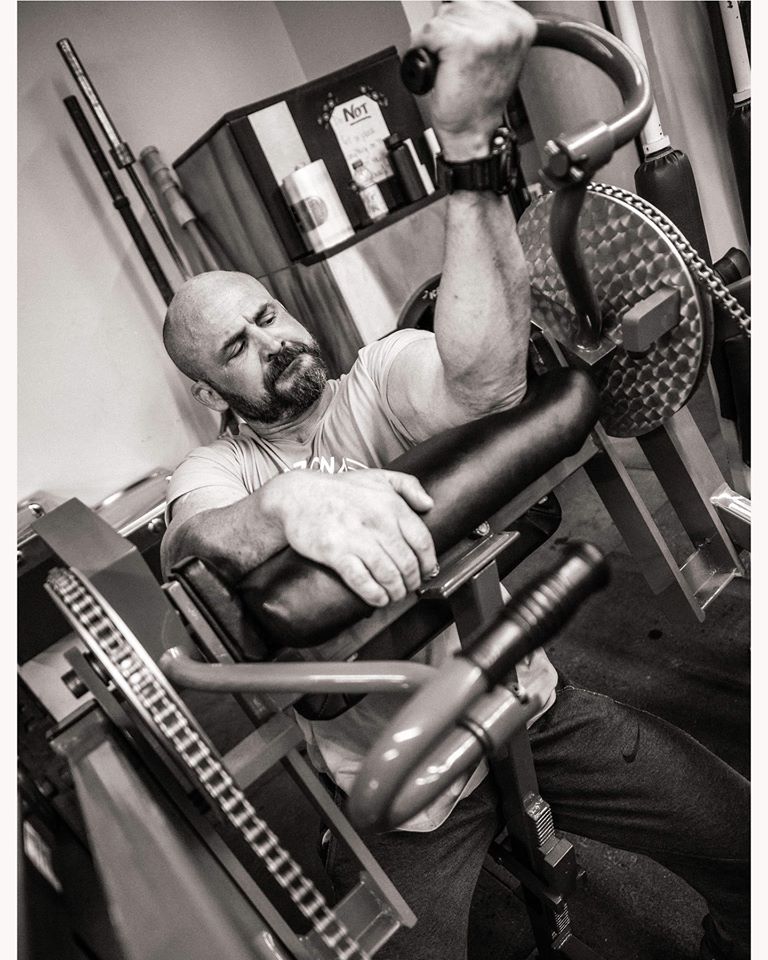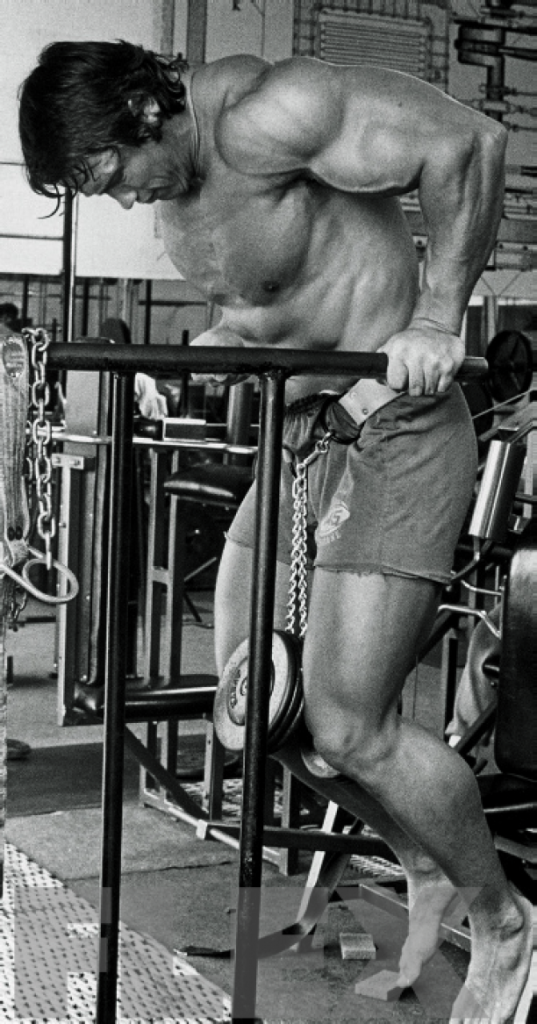In the most basic terms, Hypertrophy refers to an increase in the size of a…
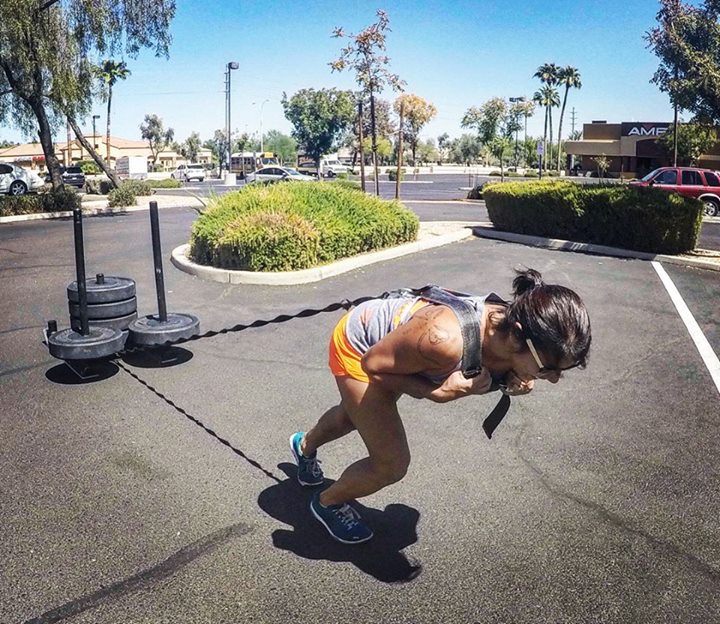
More Fun with Sleds
More Fun with Sleds
Some sports (and professions) require athletes to switch quickly between strength-based and endurance-based tasks. One way to address this demand in training is to blur the lines between strength and conditioning. This can be accomplished by integrating the sled with running and/or other movements.
Shuttles
Shuttles are an efficient way to structure sled workouts. In the case that the workout calls for a 40yd Shuttle and an 80yd Shuttle, place a cone at 20yd and a cone at 40yd. By completing a shuttle (out and back) to the 20yd cone, you have completed a 40yd shuttle. By running to the 40yd cone and back, you have completed an 80yd shuttle.
Determining Load
For an explanation of loading, please refer to previous article: “9 Conditioning Workouts for the Sled”
Combining Sleds & Running
In this workout, you alternate between sled push shuttles and shuttle runs. The runs are twice as long as the sled push; this makes it so that the shuttle run concludes back at the sled. This workout is based on a 1:1 work:rest ratio, which can be accomplished by alternating rounds with a partner or timing your work and taking an equivalent rest.
The effect of this workout can be changed based on the amount of weight used on the sled. A lighter sled will result in a faster workout, but may fail to achieve the strength stimulus of a heavier sled.
Set your objective prior to beginning the workout and choose a weight that will allow you to accomplish that objective. One example of selecting an objective would be: “to complete the workout without walking while pushing the sled.” It’s not unusual to be able to run the sled for the first portion of the workout and then break down to a walk. This isn’t necessarily a bad thing; you’re still placing significant stress on your cardiovascular system, and this type training can be useful practice for completing heavy work under fatigue or for having to run after completing strength work.
5 rounds:
40yd Sled Push
80yd Shuttle Run
40yd Sled Push
80yd Shuttle Run
(rest equal to work between rounds)
There are an infinite number of ways to structure the work when combining the sled with running.
5 rounds for time:
20yd Sled Push
40yd Shuttle Run
20yd Sled Push
-rest while your partner works-
40yd Sled Push
80yd Shuttle Run
40yd Sled Push
(walk 2:00 between rounds)
Flow of the above workout:
(Partner 1: 20yd push, 40yd run, 20yd push then partner 2 does the same. Next Partner 1: completes a 40yd push, 80yd run, 40yd push and then partner 2 does the same. They both walk 2:00 and start the next round.)
The following is similar to the above workout, but with an emphasis on covering more ground, largely through more running.
4 rounds for time:
40yd Sled Push Shuttle
200m Jog
80yd Sled Push Shuttle
400m Jog
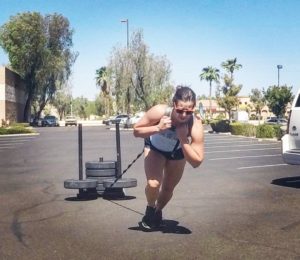
You can make things even more interesting by including a third element: calisthenics!
3 rounds for time:
80yd Sled Push Shuttle
200yd Run
50 Air Squats
200yd Run
5 rounds for time:
20yd Sled Push
10 Burpees
20yd Sled Push
10 Burpees
(rest 1:00 between rounds)
For time:
1 Mile Run
100yd Sled Push Shuttle (heavy load)
100 Air Squats
2 rounds for time:
100yd Sled Push
1000yd Run
100 Air Squats
_______________________________________________
Don’t forget to include the rower!
5 rounds for time:
100m Sled Push Shuttle
200m Run
300m Row
(rest 2:00 between rounds)
For time:
1000m Row
100yd Sled Push Shuttle
800m Row
80yd Sled Push Shuttle
600m Row
60yd Sled Push Shuttle
400m Row
40yd Sled Push Shuttle
200m Row
20yd Sled Push Shuttle
________________________________________________
More Strength:
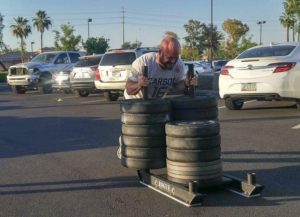
5 rounds for time:
40yd Sled Push Shuttle
3 Power Cleans at body weight
(alternate rounds with a partner)
For time:
100yd Sled Push Shuttle
10 Tire Flips
80yd Sled Push Shuttle
8 Tire Flips
60yd Sled Push Shuttle
6 Tire Flips
40yd Sled Push Shuttle
4 Tire Flips
20yd Sled Push Shuttle
2 Tire Flips
For load:
15yd Sled Push
(rest as needed. Add weight each set. Continue until unable to complete the distance without walking)
________________________________________________
Sled Sprints:
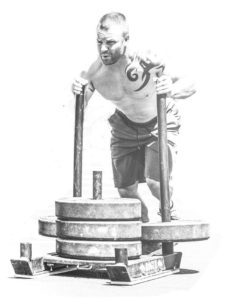
This is another animal entirely. The focus shifts toward speed, which creates greater demand for recovery between efforts. Sprinting with the sled can also be rougher on your body than slower pushing. By increasing the speed, we are recreating much of the impact and force that occurs when sprinting. This type of training will typically lead to some soreness, and will have more impact on the athlete’s ability to train at a high intensity in the near future.
Performing Sled Sprints
The use of sleds for speed training is rapidly gaining popularity. This is particularly true for field sports that involve significant contact. There are two primary reasons behind this increase in popularity.
1. Sleds keep the athlete in the “Drive Phase” of a sprint.
2. Sleds are great for increasing the capacity to generate horizontal force.
This is unique because most strength training is dependent on the vertical pull of gravity—take, for example, the squat. When performing a squat, the bar is resting across the athlete’s shoulders and the barbell is being pulled straight down by the force of gravity. Training to develop strength by generating vertical force does translate into an increased ability to generate horizontal force, but it is probably not as efficient as training by exerting force in the horizontal plane
The Force of Gravity
Training to develop strength by generating vertical force does translate into an increased ability to generate horizontal force, but it is probably not as efficient as training by exerting force in the horizontal plane.
The load used in a sled speed workout can be looked at in two ways.
1. Load should be very light (approximately 10% of body weight). The lighter load will allow the athlete to move quickly and replicate more closely the movements of sprinting. This falls into
the dogma of train fast be fast, train slow be slow. This is the traditional view and is often being disregarded by many sports performance coaches.
2. Load should be heavy. This builds strength and allows the athlete to replicate the drive phase of sprinting. This follows the belief that developing absolute strength is a crucial
and oft-neglected component of speed.
Allow full recovery between efforts. Speed is The Priority.
5x 10yd Push
4x 20yd Push
3x 30yd Push
2x 40yd Push
3 rounds:
Start a Sprint Every Minute:
10yd Sled Push
20yd Sled Push
30yd Sled Push
40yd Sled Push
50yd Sled Push
(rest 3:00 between rounds)
Sprint Relay Workouts
Relays are an efficient way to manage large groups of athletes. It is vital that we respect the time of the athletes that we coach. It is not acceptable to waste their time due to a lack of creativity or a lack of planning.
For example, you have 5 sleds and 25 athletes to run through a training session. The least-efficient way to manage the training session would be to have one athlete working on a sled at a time.
That would mean that one athlete would complete 5x40yd, (rest 3:00), 4x40yd (rest 3:00), 3x40yd, (rest 3:00), 2x40yd, (rest 3:00). This would require each athlete to have a sled for approximately 26:00. It is much more efficient to run the sprints as a relay. With 5 athletes on a team, the athletes will get nearly the same amount of recovery as they would running by themselves. Running sprints as a relay also elicits greater effort from most athletes due to the tendency of the relays to become races.
4-5 Person Sprint Relay
5x40yd Sled Pull
(rest 3:00)
4x40yd Sled Pull
(rest 3:00)
3x40yd Sled Pull
(rest 3:00)
2x40yd Sled Pull
(rest 3:00)
1x40yd Sled Pull
(increase weight each set)
4-5 Person Relay:
5x10yd Sled Push Sprint
(rest 2:00)
5x20yd Sled Push Sprint
(rest 2:00)
5x30yd Sled Push Sprint
(rest 2:00)
5x20yd Sled Push Sprint
(rest 2:00)
5x10yd Sled Push Sprint
Alternate Shuttles with a partner:
3x20yd Sled Push Shuttle
(1:30 walk)
3x40yd Sled Push Shuttle
(1:30 walk)
3x60yd Sled Push Shuttle
–200yd Recovery Jog-
2x20yd Sled Push Shuttle
(1:30 walk)
2x40yd Sled Push Shuttle
(1:30 walk)
2x60yd Sled Push Shuttle
-200yd Recovery Jog-
1x20yd Sled Push Shuttle
(1:30 walk)
1x40yd Sled Push Shuttle
(1:30 walk)
1x60yd Sled Push Shuttle
-Bachelor of Scie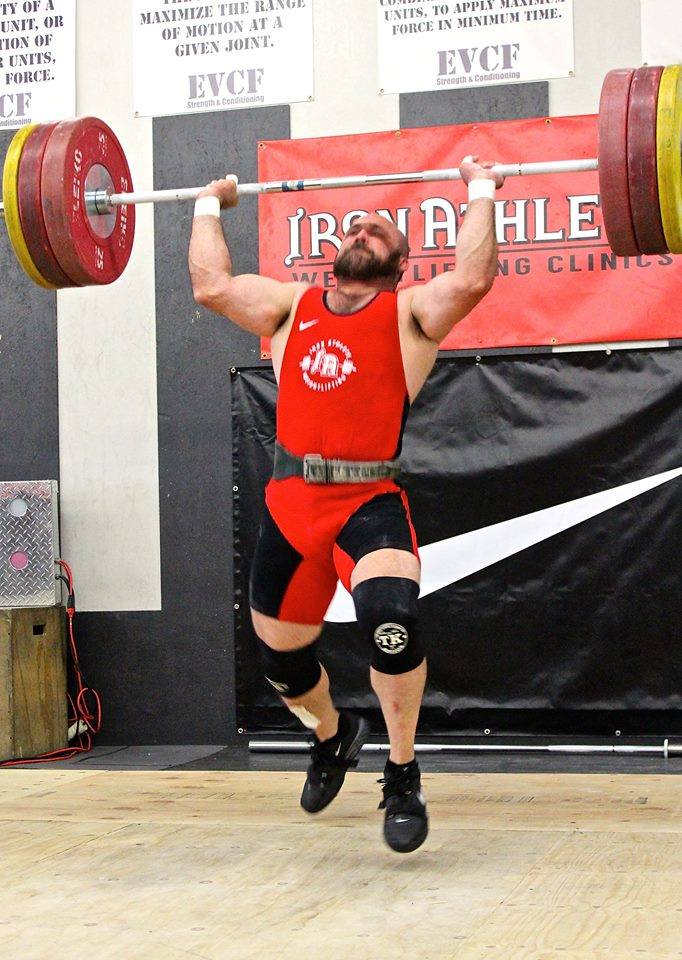 nce, Auburn University 1997
nce, Auburn University 1997
-Master of Education, Northern Arizona University 2005
-USA Weightlifting Club Coach 2001
-CrossFit Level 1 Instructor 2009
-USA Weightlifting National Coach 2012
-EVCF Regional Team Coach 2013, 2014, 2015, 2016, 2017
-EVCF CrossFit Games Team Coach 2014
-Masters National Record Holder: Snatch 130kg & Total 287kg (105kg 40-44)
-5 x American Masters Weightlifting Champion
-5 x American Masters – Best Lifter (2 x 35-39yrs, 3 x 40-44yrs)
-3 x Masters Nationals Weightlifting Runner-up
-President of Arizona Weightlifting Federation – LWC 48, 2016-current
